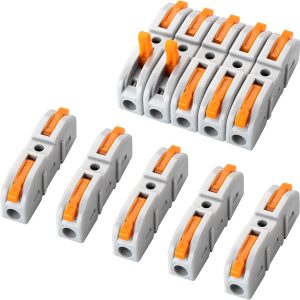Project Report For Splicing Connectors
Introduction
Project Report For Splicing Connectors is as follows.
Splicing connectors are one method of permanently connecting two optical fibre lines. This procedure is also known as termination or connecterization. When two types of cables (for example, 48-fiber cable and 12-fiber cable) are linked together for a longer run with a single length of fibre cable, this approach is usually favoured. Splice connections, also known as butt connectors, butt splices, or crimp connectors, have been used for decades and continue to be a significant component of 12-volt electrical systems.
Splice connections, also known as butt connectors, butt splices, or crimp connectors, have been used for decades and continue to be a significant component of 12-volt electrical systems. Here are some fundamentals to help you choose and use them.
While there are benefits to soldering, the time and money needed might be prohibitive. Furthermore, the extreme heat utilised in soldering poses a danger of harm. A butt connection is easier, quicker, and, in some ways, safer to use. Even inexperienced mechanics and technicians may quickly and simply insert both wire ends into either end of a butt connector and crimp for a solid connection. Butt connections are available with a variety of conductors, the most common of which are copper or steel.
Tin plated copper is the most common conductive substance used in splice connections. Tin plated copper is a very affordable material that works well in a variety of applications. It is extremely conductive, crimpable, and corrosion-resistant. For high-temperature applications, nickel-plated steel, a more costly and less bendable material, is the chosen conductor.

Types Of Splicing Connectors
Heat shrink Butt Connectors :- Heat shrink butt connectors are high performance wire splicing connections developed in the United States that are intended for use in severe environments such as outdoor or wet settings. These butt connections may be crimped with any standard crimping tool’s insulated crimp nest. To achieve the best crimp on your splice, use the suitable colour coded nest. Excellent marine, automotive, and outdoor splicing connector. Heat shrink insulation is colour coded to correspond with the wire gauge sizes that each splice supports.
Butt Connectors in Gauge Yellow Heat Shrink :- Use these 12-10 Gauge Yellow Heat shrink butt connectors for the greatest electrical splicing. High grade heat shrink insulated butt splice produced in the United States with 20% more copper than competitive foreign splices. Provides the utmost in moisture, chemical, and contaminant protection for your 12 gauge and 10 gauge cables. Use the yellow crimp nest on any standard set of wire crimping tools to secure the butt connection to your wire. Then, using a heat gun or torch, shrink the insulation and loosen the glue. The connection will then be sealed and secure. Excellent for use in automobile, marine, and recreational vehicle applications.
Butt Connectors for High Temperature :- High temperature butt splices are made of nickel plated steel and can withstand temperatures as high as 900°F (482°C) in applications such as ovens and heaters, as well as engines. The entrance is flared for ease of wire insertion. Wire diameters ranging from 22 gauge to 10 gauge are available. Nickel plating is corrosion and thermal breakdown resistant.
Butt Connectors Without Insulation :- Non-insulated 22-10 Gauge butt splices are tin plated copper butt splices that come in three diameters. Check out our bigger sized non-insulated butt splices if you require a butt splice for a wire or cable greater than 10 gauge. When placing your wires into the ends, these butt splices have a butted seam with a dimple in the centre that works as a wire stop. The ends are also curled to keep your wire strands from spreading as you push them into the splice.
Project Report Sample On
Splicing Connectors
Get Completely Custom Bankable Project Report
Market Potential for Splicing Connectors
From 2022 to 2030, the market for connector splices is anticipated to expand at a CAGR of 5.5%.
Until a few years ago, the Splice on Connector market has been steadily expanding, and this trend is anticipated to last until 2030. The transition to more environmentally friendly and sustainable products is one of the major industry trends in the splice on connector market. Customers are increasingly looking for products that are manufactured with sustainable and natural materials as they become more aware of how their purchases affect the environment. The demand for goods created with biodegradable materials and without hazardous chemicals has increased as a result of this.
The market for splice on connectors is expanding due in large part to the widespread use of these products in places including offices, campuses, government buildings, schools, and healthcare facilities. During the forecast period, it is anticipated that increased demand for splice on connectors for residential building wiring applications, lighting installation processes and tools, and in-building wiring equipment would help the market grow. Splice on connections are an excellent option on the market right now because of advantages including their simplicity, index matching gels, less need for hand polishing, dependability, consistent outcomes, and superior connectivity precision.

